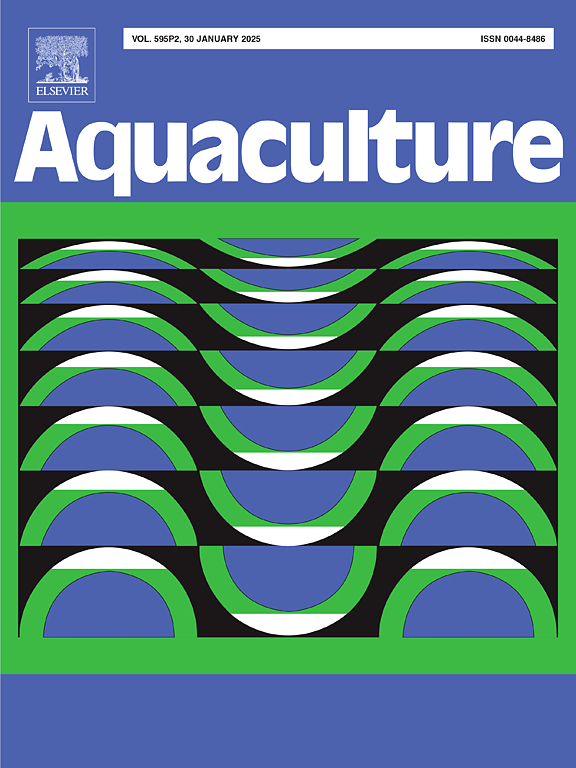Seasonal variation in two culture systems and genome-wide association analysis of taurine content in the foot muscles of the Pacific abalone (Haliotis discus hannai)
IF 3.9
1区 农林科学
Q1 FISHERIES
引用次数: 0
Abstract
Abalone is one of the most economically valuable shellfish in the world's aquaculture industry, and as production has increased, it has led to a diversification of market quality needs. Taurine, an essential amino acid component, has yet to be well investigated for its seasonal variation and genetically associated genes or loci in Pacific abalone (Haliotis discus hannai). In this study, we investigated the variation of taurine content in different seasons under two typical culturing systems in southern China. In addition, we conducted a genome-wide association study (GWAS) with 274 abalone array sequencing and phenotypic data of taurine content. The results revealed that the taurine content showed a trend of significantly decreasing and then increasing with seasonal changes. Individuals farmed in land-based industrial culture system had a greater taurine content than those farmed in sea-based floating raft culture system, with notable differences observed between May and September. A total of 69,530 high-quality SNPs and 274 individuals were identified by quality control. And 32 significantly related SNP loci of taurine content were identified by GWAS, with chromosome 9 hosting the lowest P value. A total of 33 candidate genes, including SLC6A7, EGF1, B3gnt6, and Ptpra, were annotated. These genes may be connected to amino acid synthesis, transmembrane transport, energy production, protein phosphorylation, and other processes. Among them, genes belonging to the SLC6A family may be the key gene taurine content. This study helped us better understand the genetics of the taurine content of Pacific abalone.
两种培养体系的季节变化及太平洋鲍鱼足部肌肉中牛磺酸含量的全基因组关联分析
鲍鱼是世界水产养殖业中最具经济价值的贝类之一,随着产量的增加,它导致了市场质量需求的多样化。牛磺酸是一种必需氨基酸成分,其在太平洋鲍鱼(Haliotis discus hannai)中的季节性变化和遗传相关基因或位点尚未得到很好的研究。本研究对中国南方两种典型栽培体系下不同季节牛磺酸含量的变化进行了研究。此外,我们对274只鲍鱼进行了全基因组关联研究(GWAS),并对其进行了测序和牛磺酸含量的表型数据。结果表明,牛磺酸含量随季节变化呈现先显著降低后升高的趋势。陆基工业养殖系统养殖个体的牛磺酸含量高于海基浮筏养殖个体,5月和9月间差异显著。通过质量控制共鉴定出69,530个高质量snp和274个个体。GWAS鉴定出32个与牛磺酸含量显著相关的SNP位点,其中第9号染色体的P值最低。共注释了33个候选基因,包括SLC6A7、EGF1、B3gnt6和Ptpra。这些基因可能与氨基酸合成、跨膜运输、能量产生、蛋白质磷酸化和其他过程有关。其中,属于SLC6A家族的基因可能是牛磺酸含量的关键基因。这项研究帮助我们更好地了解太平洋鲍鱼中牛磺酸含量的遗传学。
本文章由计算机程序翻译,如有差异,请以英文原文为准。
求助全文
约1分钟内获得全文
求助全文
来源期刊

Aquaculture
农林科学-海洋与淡水生物学
CiteScore
8.60
自引率
17.80%
发文量
1246
审稿时长
56 days
期刊介绍:
Aquaculture is an international journal for the exploration, improvement and management of all freshwater and marine food resources. It publishes novel and innovative research of world-wide interest on farming of aquatic organisms, which includes finfish, mollusks, crustaceans and aquatic plants for human consumption. Research on ornamentals is not a focus of the Journal. Aquaculture only publishes papers with a clear relevance to improving aquaculture practices or a potential application.
 求助内容:
求助内容: 应助结果提醒方式:
应助结果提醒方式:


